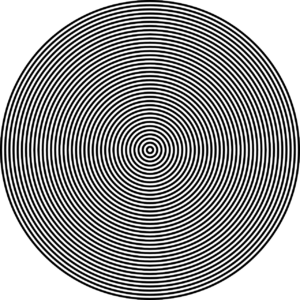Products We Love: Bifocal Contacts

Right up there with daily contact lenses, bifocal contacts have evolved and progressed in recent years. They’ve actually been around longer than dailies, but we’re using them more and more all the time. When contact lens wearers get to the point in life where they also need bifocals, things can get frustrating. We think you shouldn’t have to choose between distance and near vision, you should get to have both! That’s where bifocal contacts come in.
The Principle Behind Bifocal Contacts

Unlike bifocals in a pair of glasses which have a portion in the bottom of the lens designated for reading power, bifocal contacts work on the principle of concentric circles. When we begin to read or concentrate on something up close, three things happen:
-Our eyes focus
-Our eyes pull together
-Our pupils constrict
Bifocal contacts contain the most reading power directly in the center of the lens, so that when these three things happen you are looking through the bifocal power. As you look far away, your eyes relax and your pupils return to their normal size, allowing you to look around the center circles of reading power. Your eyes will then take advantage of the outer circles which contain your distance prescription.
Bifocal Contacts: What You Should Expect
One thing that people don’t always know is that your vision with your contacts will always be a bit different than the vision you have with your glasses on, and this is especially true of bifocal contacts. Because contacts are physically placed on your eye instead of in front of your eye like glasses, the prescription will be a slightly varied, and switching between your specs and your contacts will be a definite adjustment.
It’s also important to keep in mind that when it comes to bifocal contacts, usually either your distance or your near vision will be a little better. Your optometrist should be able to tweak this. So if you’re a person who does reading or computer work for the majority of the day, ask for the focus of your lens to be on getting you reading power crisp, and just be aware that the distance vision will be slightly fuzzy. The opposite can be accomplished for those who depend more heavily on their distance vision and don’t read quite as much.
Bifocal contacts are also usually not a one-and-done fitting. Your eye doctor will probably have to bring you back in to the office several times to tweak and adjust the fitting and power. It’s normal; almost everyone has to try a few lenses before they get the right combination.
Keeping these few things in mind will help you to know what to expect in the process of narrowing down all the choices to the perfect bifocal contacts for you!
Are Bifocal Contacts For Everyone?
It depends upon you as an individual if you will like bifocal contacts, but almost everyone can at least give them a shot! Bifocal contacts come as both soft and hard lenses. Because they are initially more comfortable, we fit as many people into soft lenses as possible. However, if you have a high amount of astigmatism in your prescription, hard bifocal contacts will work better for you. Your optometrist will be able to evaluate your eyes and vision and give you a recommendation as to which material and brand of bifocal contacts would work best.
Bifocal Contacts at Vision Source Meadville
At Vision Source Meadville, we fit people in bifocal contacts all the time! There are several different brands that we like, but our go-tos are the Air Optix Multifocal and the Bausch and Lomb Ultra for presbyopia. We’ve also begun to have good result with certain daily multifocal lenses!
If you are interested in bifocal contacts, we’re happy to have you come in for a contact lens evaluation. We’ll take measurements of your eyes and give you some free trials to use until we find the right ones for you. Don’t choose between distance and near vision – enjoy them both with bifocal contacts.
